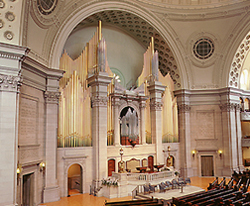If you asked people how they fell about “room acoustics,” you’ll find that many don’t even know what it is. We’re immersed in reflected sound every minute of every day, but it’s largely taken for granted unless it becomes very annoying.
In a given congregation, it’s likely that the majority don’t really care about the acoustics of the proposed new assembly hall. A heavily padded room that’s suitable for electronically amplified music and speech production is fine with them.
However, it’s just as likely that there will be some people who are passionate about how the room sounds. They may prefer traditional music and have an appreciation for the acoustic environment required to enhance its presentation.
Indifference and passion are not a good mix, especially when you consider that the possible solutions are potentially very expensive. Let’s look at both sides of this issue rather than present a singular viewpoint.
Traditional Western music finds its roots in Europe, where it evolved and developed over many centuries. Many of the great composers were full-time employees of the state, and the composition and performance of musical works had great social and political significance.
Even today, every major European city (and most smaller ones) have one or more concert halls where music aficionados can enjoy a classical performance.
Music has been around much longer than sound reinforcement systems. For most of human history, the acoustic environment was looked to for amplification and tonal enhancement.
Many of the most popular musical pieces in history were written to syncopate with reflections from the room, and could only be presented properly if the room volume was correct. Room reflections were the only way to amplify music instruments.
Wind, string, and brass ensembles used shells to provide amplification so that larger audiences could be entertained. Reflected sound plays a vital role in the presentation of traditional music.
Another source of amplification was the use of ensemble of the same instrument. A violin section is much louder than a single violin, and the inherent timing and pitch differences produced a sound rich in harmonic content.
As sections were combined to produce larger ensembles, a conductor was required to keep everyone playing together, and to provide visual cues for loudness and tempo. It became apparent that a skilled conductor was vital to a good performance, and many of them gained greater notoriety than the musicians themselves.
Any classically trained musician is fully indoctrinated into the importance of room acoustics in live performance.




















